I took a break from teaching and sewing and breaking my brain over the stays pattern to plant some trees today.
Tree planting has been on my to-do list all winter. It’s a way to be literally hands-on helping the environment.
Tree planting in NZ is a winter event: you want to get them in the ground while there is plenty of water, and take advantage of the spring growth spurt to get them rooted in before the dry summer.
I missed the early winter events because of colds, but got in for the last of the planting today. There weren’t as many planting events as I’d hoped in Wellington (I feel like we should be desperately planting trees in every possible space…maybe next year), but I found Conservation Volunteers New Zealand, and signed up for a planting.
Sixty willing volunteers showed up bright and early this morning at Tawatawa Reserve in Owhiro/Island Bay, bundled up in layers of wool and waterproof jackets, feet encased in proper shoes, and spades in hand.
We came from all walks of life: there were lonely solos like me, and couples doing it as a weekend activity, families with kids, church groups and school groups, people from Extinction Rebellion, and retirees who do this as a hobby (and had done it almost 40 times this winter alone!). All come together to create a bit of beauty and hope in an increasingly scary world.
After getting our initial briefing, we trotted into the reserve, uphill and down, until we arrived at our object: 1,000 natives, ngaio and wharariki, hebe and mÄnuka (possibly kÄnuka, but I’m pretty sure it was mÄnuka), karamu, tororaro and others, all ready for us to plant:
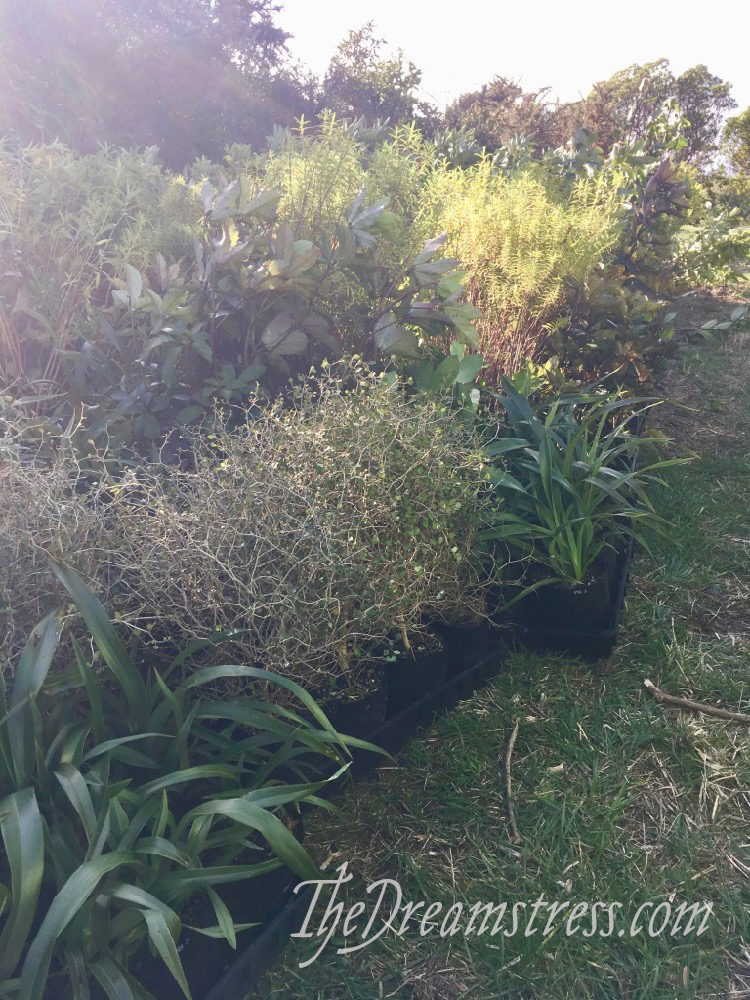
We had a mihi (introduction) and karakia (prayer), and then picked up as many plants as we could carry, and walked on to our planting site: a steep slope looking out over the island that gives Island Bay its name:
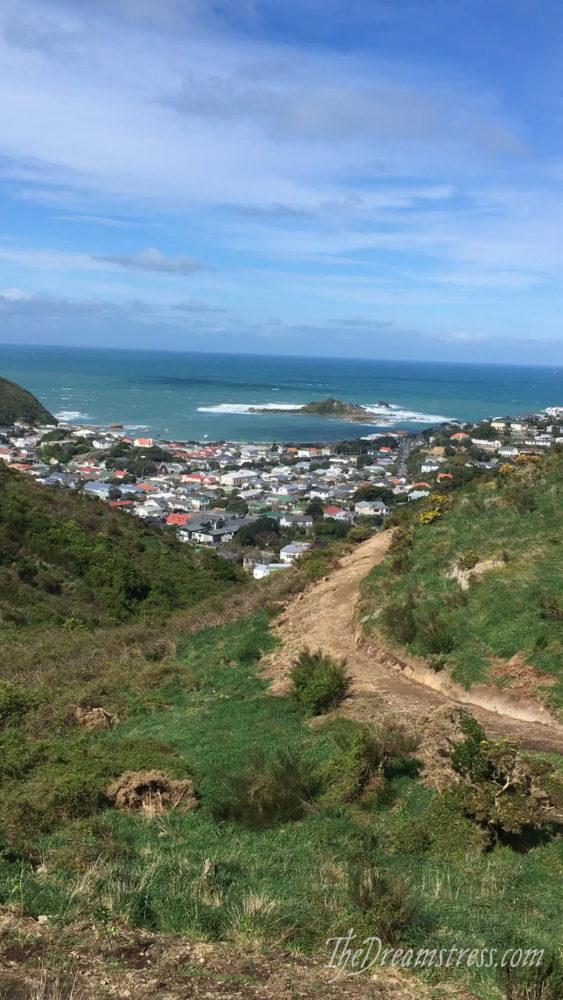
I was slightly worried about how chillblained my hands were going to get, as we’re having one of the coldest snaps of winter, but blissfully, CV provided wonderfully warm gloves. (If you wear gloves and your me-made pants are silk and wool (even if they look like sweatpants) it qualifies as a Costumers for Climate Action event. Maybe next year I’ll come in medieval gear and put them to the test as working clothes ;-))
Despite the cold, you stay quite warm scrambling around on a rough hillside, digging holes and planting trees!
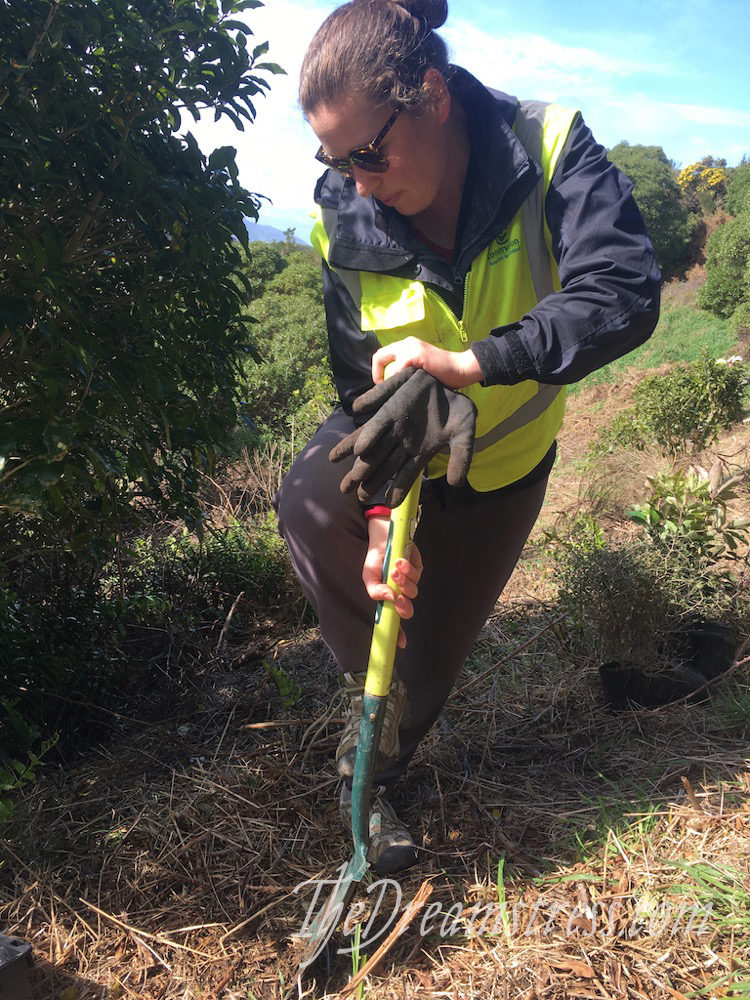
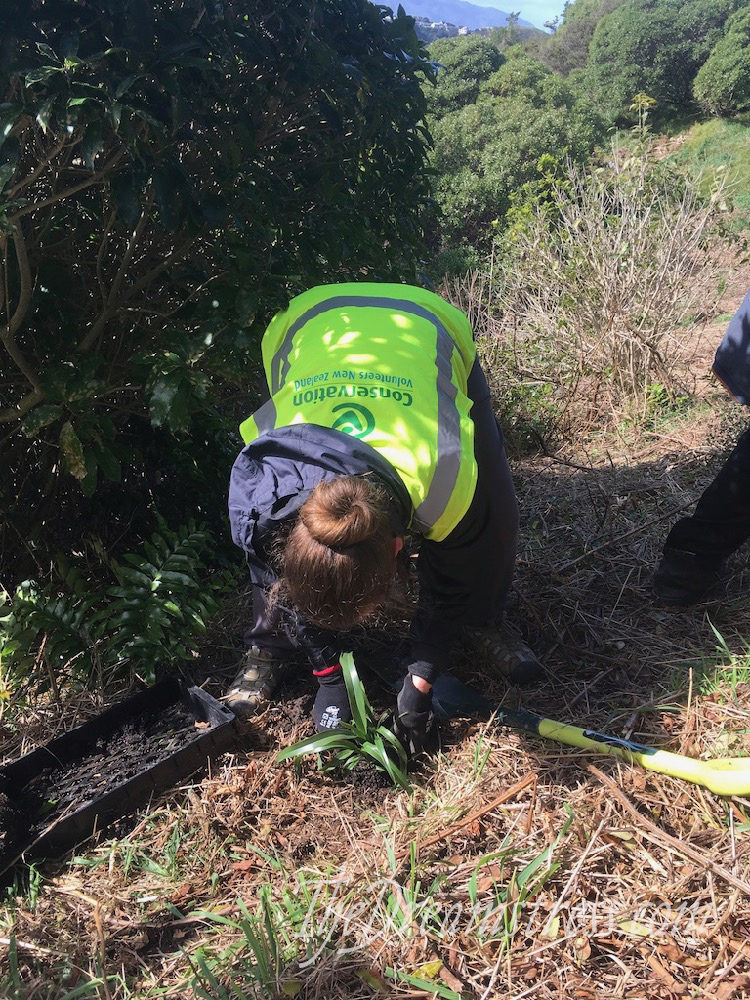

Not just trees though: we planted a wide variety of natives, to create a diverse forest that would support a host of birds and enhance the overall biodiversity of the area. The photos show me planting a wharariki, a mountain flax, which has flowers that a number of birds love.
I carried over 50 plants up the hill to the steepest spot (they asked who was a bit of a mountain goat and I thought, yep, that’s me), planted 33 plants, and helped secure as many poorly-planted ones again. A days work well done! And a wonderful feeling, helping out, and watching a community come together.
It was amazing to stop on my trips up and down the hill, to watch the buzz of activity: everyone intent on their own small bit.
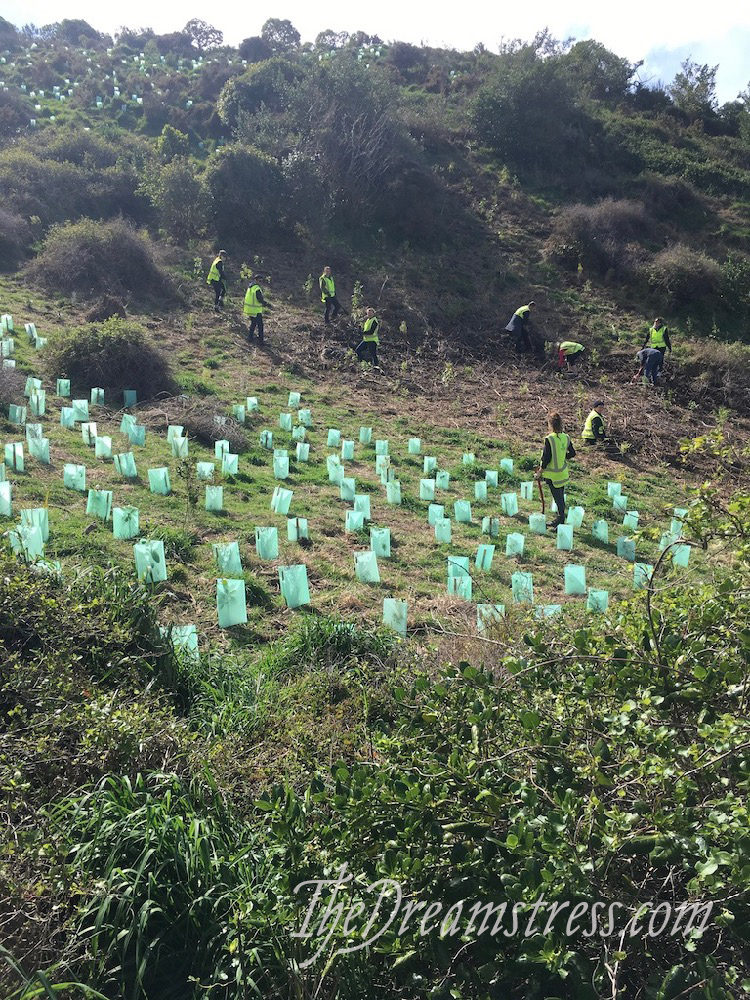
This was my last tree of the day: a lovely ngaio (very fitting for me!) that I carefully tucked in behind an established bush, to give it shelter from the wind while it gets its start in life.
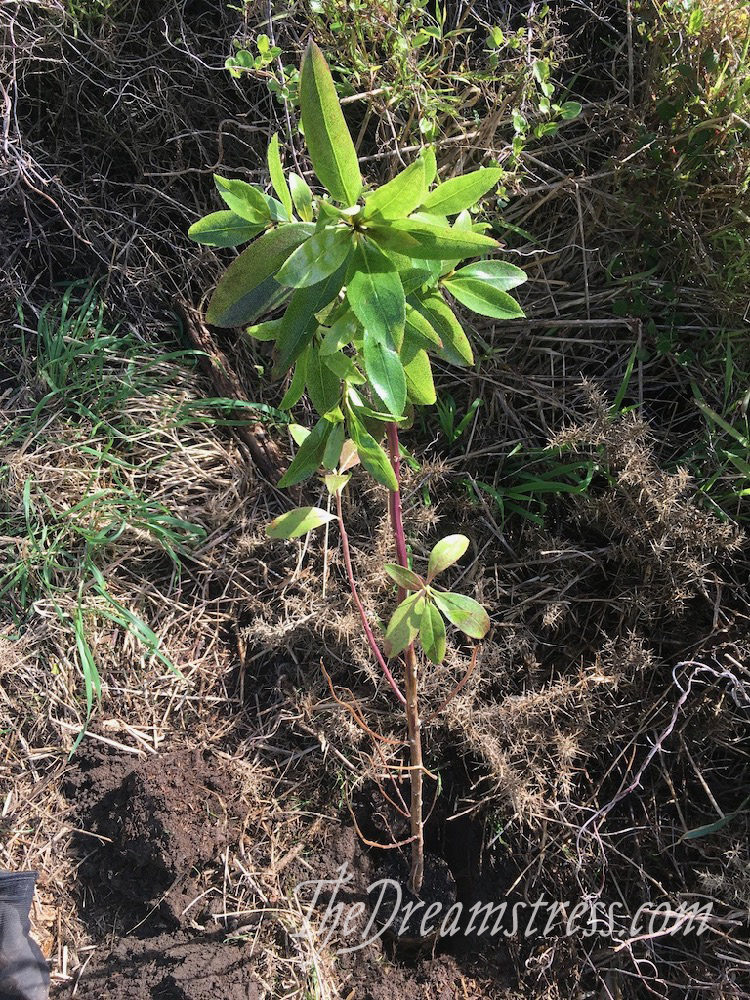
And at the end of the day, as I was quality checking the planting, and securing in any that were a bit loose, a juvenile tūī showed up to check out the forest we were creating for his great-grandchicks, and tried out his song, in anticipation of the day when these hills will be full of it.


Oh, lovely!
That’s all I’ve got, I think.
How perfect. And if I remember, your parents do permaculture, which is what seems to be taking place here: a variety of plants of various sizes to complement each other.
Thank you for sharing this experience with us.
Maybe it would be fun to have a whole Costumers for Climate Action event! All of you in your various period clothing to do this work, and then meet at a pub afterwards to talk about the experience both personally and as living history.
youtube.comLovely!!! We’re here planting natives on our hillside in Michigan USA, hoping the fall rains and winter snows will settle them into the ground for spring. We have a fair amount of woods but we’re taking out non-native and scrub and replanting with what works ecologically.
We recently saw the documentary Fools & Dreamers: Regenerating a Native Forest, a 30-minute documentary about Hinewai Nature Reserve, on New Zealand’s Banks Peninsula, and its kaitiaki/manager of 30 years, botanist Hugh Wilson, and it’s fantastic. It’s great seeing people all over the world working to keep it (and us and the other living things) alive!
https://www.youtube.com/watch?v=3VZSJKbzyMc
My dad is spending his retirement planting trees. What a kick to be part of such an important and world-wide movement! I read that Ethiopia planted 340 MILLION trees!
princeton.eduAmazing! I just had a conversation this morning with my AirBnB host, who advised me on the best seeds and mixes for sowing in empty lots and the scrubby bits of ground by bus stations. Next spring, maybe I can make my neighbourhood a bit more beautiful and pollinator-friendly. I came across this recently, which I think is wonderfully interesting, about reforestation and waste-management:
https://www.princeton.edu/news/2017/08/22/orange-new-green-how-orange-peels-revived-costa-rican-forest
A wonderful, practical activity to help the Earth. Thanks for sharing it with the rest of us.
I’m so pleased for you – a wonderful thing to be part of. I also like your idea of volunteering at a nursery to grow tree seedlings for planting. All these excellent and ambitious numbers of trees to be planted, but I always wonder who is growing the seedlings? No one is set up for this level of planting, and I do wonder where on earth Ethiopia got all those young trees. Love the photos of Island Bay – you can imagine how it will look when the hills are forested again.
theguardian.comI am unsure–but here is the article:
https://www.theguardian.com/world/2019/jul/29/ethiopia-plants-250m-trees-in-a-day-to-help-tackle-climate-crisis
I recently read a book on the botanical/horticultural history of the Wellington region, and it was so depressing to see all those glorious forested slopes razed bare in so few years. Honestly, it looked like a post-apocalyptic prison colony. (Who thought that was a good idea???)
So it’s wonderful to know that the hills will be covered in native forest again! Here in the Hutt we have rather too much gorse, but I know people who go about ‘seed-bombing’ with native plants. And apparently gorse makes a good nursery shelter for native trees, so at least it’s not a complete waste of space!
Deborah, that gorse is now a nursery plant for natives and if you look at the hills above Te Whiti, much of it is now native bush again. When I was a teenager it was all gorse. Happily the gorse is a great nanny. Things are getting better for those hills.
Finding this out made me very happy (I have been working with a bunch of eco conservators and have learned a lot about such things)
So good to see trees being planted, it’s what we need now more than ever.
Tree planting in medieval costume, there’s a thought
You mean, “There’s an AWESOME thought”.
Dear Leimomi,
What a treat to go along with you on your tree-and native plant planting expedition. May that fold in the hills become lush and full of birdsong–may it sink lots of carbon! What a view to the bay. New Zealand is astonishingly, heart-breakingly beautiful.
Very best,
Natalie